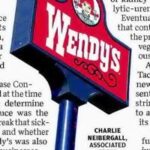Foodborne illness outbreaks are uncommon in well-known restaurant chains, but they can occur. An outbreak of E. coli food poisoning linked to McDonald’s Quarter Pounder hamburgers has affected at least 49 people in 10 states, resulting in one death and 10 hospitalizations.
McDonald’s stopped the distribution of slivered onions and temporarily removed the Quarter Pounder from menus in several states.
Here is a brief overview of incidents that have made customers ill, disrupted businesses, and sometimes influenced food safety regulations in the United States.
In August 2022, Wendy’s removed lettuce from sandwiches in its Michigan, Ohio, and Pennsylvania locations after reports of people getting sick.
People are also reading…
The Centers for Disease Control and Prevention (CDC) was investigating at the time to determine if romaine lettuce was the source of an E. coli outbreak that affected at least 37 people and if the romaine used at Wendy’s was also distributed or sold at other establishments.
According to the CDC, one person in Indiana also fell ill.
In 2015, Chipotle faced an E. coli outbreak that sickened over 50 individuals, leading to the temporary closure of numerous West Coast restaurants. Subsequently, 30 Boston College students, including members of the men’s basketball team, reported gastrointestinal symptoms after dining at a Chipotle outlet.
Although federal officials declared the outbreak over by February 2016, Chipotle closed all its restaurants to retrain employees and regroup.
By the end of the year, Chipotle Co-CEO Montgomery Moran stepped down due to plummeting sales.
In 2020, Chipotle Mexican Grille agreed to pay a $25 million fine to settle criminal charges related to serving contaminated food that caused illness in over 1,100 people in the U.S. between 2015 and 2018.
The company acknowledged that inadequate safety practices, such as improper food temperature maintenance to prevent pathogen growth, led to illnesses in customers across Los Angeles, Simi Valley, Boston, Sterling, Virginia, and Powell, Ohio.
Chipotle is currently one of the top-performing chain restaurants in the U.S., generating nearly $10 billion in sales last year.
In December 2006, Taco Bell removed green onions from all 5,800 of its restaurants nationwide following findings of a severe strain of E. coli in samples. The outbreak affected at least 71 individuals in New Jersey, New York, Pennsylvania, and Delaware, with many hospitalized, according to the CDC.
Eight people developed hemolytic-uremic syndrome, a form of kidney failure. It was later determined that contaminated lettuce was likely the cause, as it was used in various menu items.
Taco Bell promptly launched a newspaper ad campaign and had its president conduct multiple media interviews to reassure customers of the safety of their food.
Taco Bell successfully recovered, with sales increasing by 6% last year as the company expanded with over 200 new locations.
Between 1992 and 1993, four deaths and over 700 illnesses in Washington, Idaho, California, and Nevada were linked to undercooked E. coli-contaminated hamburgers from Jack in the Box.
The subsequent investigation by federal regulators led to changes in U.S. regulatory practices, according to experts.
A CDC investigation identified five slaughter plants in the U.S. and one in Canada as probable sources of the contaminated meat, and potential control points were identified to reduce contamination risks. The animals slaughtered in domestic facilities were traced back to farms and auctions in six western states, although no specific slaughter plant or farm was pinpointed as the exact source.
The U.S. Department of Agriculture enforced a Hazard Analysis and Critical Control Point system to identify and manage hazards within food production systems. This system increased monitoring and control measures to quickly contain outbreak spread.
Jack in the Box incurred losses exceeding $44 million in 1993 and did not return to profitability for three years.
The company eventually recovered, reporting $1.7 billion in sales last year, marking its third consecutive year of double-digit sales growth.





